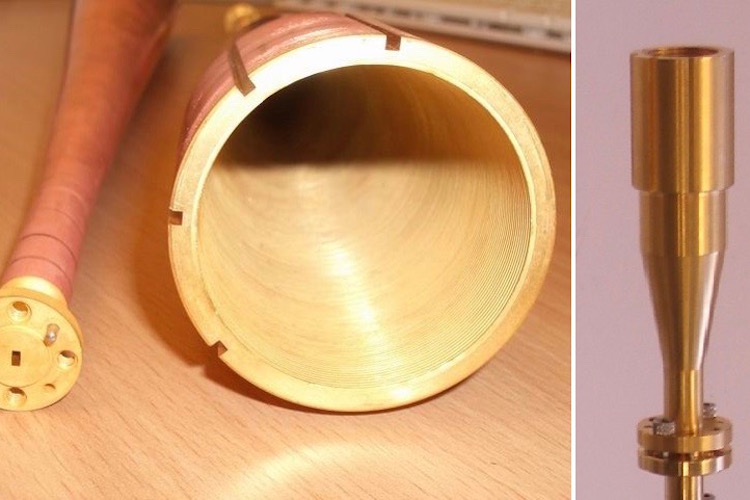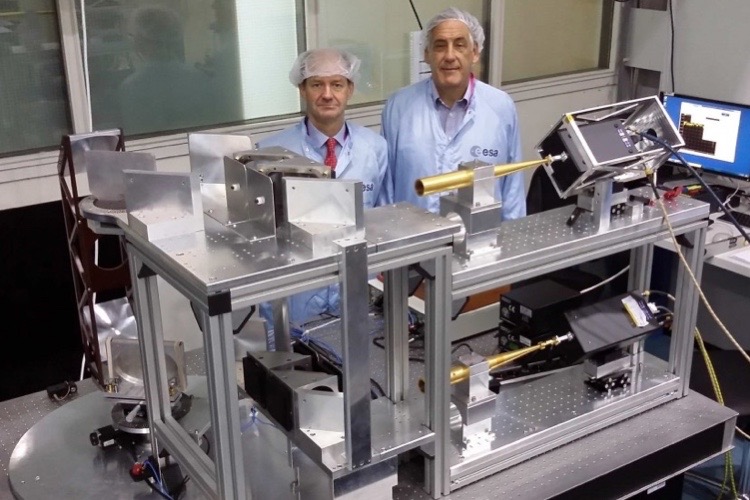High performance millimetre wave feedhorn antennas
Millimetre and submillimetre waves (30 to 1000 GHz) occupy a technologically important region of the electromagnetic spectrum and are increasingly exploited. Applications include:
- satellite remote sensing using radiometer payloads for meteorology
- electron spin resonance (ESR) spectroscopy and dynamic nuclear polarisation (DNP) for biological and chemical analysis
- astronomy to measure molecular clouds and the cosmic microwave background
- material characterisation and metrology to support technology development
- very high data rate communications.
Much of the instrumentation used in these applications uses quasi-optics (i.e. mirrors, polarisers etc) to manipulate signals as free space Gaussian beams. Key enabling devices are feedhorn antennas to couple between sources or detectors and free space. They are also used to feed larger reflector antennas. As higher performance quasi-optical instruments are increasingly demanded, the performance of feedhorns has also had to increase, for example, to achieve higher Gaussian beam coupling efficiency, lower sidelobes, or more compact designs for lower size or weight.

High-performance millimetre wave feedhorn antennas. Credit: Duncan A. Robertson, University of St Andrews
The Millimetre Wave and ESR Group, led by Professor Graham Smith, was motivated to develop next-generation ESR spectroscopy instrumentation, and began conducting research into advanced corrugated feedhorns. Conventional linear profile corrugated horns couple to a fundamental mode Gaussian beam with around 95-98% efficiency. The residual energy exists in higher-order modes which contributed to unwanted sidelobes (typically at the -25 to -30 dB level) and gets trapped in high-performance quasi-optical systems, causing undesirable signal drop-outs at certain frequencies. The group developed a new horn design with a nonlinear internal profile which overcomes these problems to achieve Gaussian coupling of 99.7% with sidelobes and cross polarisation at the -40 dB level – these have been commercialised as 'ultra-Gaussian' horns. Further research identified different nonlinear profiles which enable world-beatingly low sidelobes (-60 dB) in ultra-compact horns (just a few wavelengths long).
These horn designs have been commercialised by industrial partner Thomas Keating Ltd, a UK scientific instrument manufacturing SME with global markets for millimetre and submillimetre wave components and quasi-optical systems. The project group has worked with Thomas Keating Ltd for many years, and they have successfully commercialised high-performance feedhorn designs. The ultra-Gaussian horns were added to Thomas Keating's catalogue in 2007, and this design has been at the heart of numerous high-performance instruments which they have delivered to customers around the world, including the European Space Agency, the National Physical Laboratory, and automotive supplier Continental. The group recently designed of a pair of very advanced feedhorns which Thomas Keating Ltd manufactured for the TROPICS CubeSat satellite constellation developed by MIT Lincoln Lab for monitoring tropical thunderstorms.

Quasi-optical scatterometer system delivered to ESA incorporating two gold plated ultra-Gaussian horns. Credit: Thomas Keating Ltd.
The successful commercialisation of the feedhorn research has brought big economic impact to Thomas Keating Ltd, strengthening a profitable business and enabling growth in staff numbers by 25% in the last decade. The feedhorns and quasi-optical systems which use them have also delivered state-of-the-art results to a wide diversity of end-users around the world in applications including ESR spectroscopy, satellite radiometers, antenna testing and metrology.